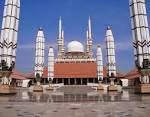.jpg)
As a center of Javanese culture, Yogyakarta save a lot of typical traditional roots. A variety of unique cultural customs are still survive amid the swift currents of modernization. One of the most distinctive cultural event is the traditional ceremony Grebeg Ageng or so-called "Ngalab Berkah" (seeking blessing). A traditional ceremony is packed regularly once a year to date. This activity is an alms ceremony and thanksgiving ceremony of Yogyakarta Sultanate, which is specifically designated for communities in Yogyakarta and surrounding areas. At first, this event is a procession ceremony organized by the palace to ward off the disaster that is feared will be rocked Yogyakarta and surrounding areas. The Sultanate of Yogyakarta and surrounding communities believe that the holding of the ceremony, they will avoid the area of disaster or catastrophe that could threaten people's lives. This event became a very sacred ceremony anticipated to get the safety and well-being. Along with the entry of Islam in Java (Yogyakarta region taught by Sunan Kalidjaga) the event finally connected with the great days of the religion of Islam, as well as to the symbols of the religion of Islam itself. There is no clear data, since when the event begins, but according to some sources and the Sultanate of Yogyakarta, this event begins while standing Yogyakarta Sultanate (1756). In connection with the establishment of religion, Islam and the feast / great Islamic religion , then within one year of the event was held three times, namely when Idhul Fitri celebrations Idhul adha and complete the most crowded and tourist attractions as well as serve maulud is the celebration of the Prophet. In further developments , the ceremony was just being a salvation or a thanksgiving ceremony for the citizens of Yogyakarta Sultanate with a mound containing crops ( agriculture and crops ) is borne by several courtiers ( a kind of traditional palace servants ) The mountains consist of two kinds, namely mountains Wadhon (women) and Lanang (male) borne from the palace of Yogyakarta ( after a special ceremony was held ) to the Grand Mosque to be blessed or religious ceremony ( islam ) by a religious leader .What's interesting about the trip procession , motorcade escorted by 10 rows of mountains / traditional palace platoon of soldiers , including the Sultan's personal guard .The soldiers , among others , Prajurit Lombok Abang ( Wiroboyo ) , Daeng ( derived from Makasar ) , Patang Puluh, Jagakarya , Prawirotomo , Bugis , Surokarso , Nyutran , Ketanggung and Mantri Jero , the third row of soldiers latter is a private army of Sri Sultan . Of course, each platoon has good clothes and different weapons .Each row also accompanied by a music line ( typically using drum , drums , gongs , flutes and trumpets ) , which is also different every ranks. Accompaniment mountains carrier is also equipped with a fairly attractive forces Aubade. Each army has certain characteristics . This event usually begins at approximately 10:00 am and last until 13:00 pm. Arriving convoy mountains in the Great Mosque courtyard and after receiving the blessing of religious leaders , as the peak of the blessing of these mountains may digerebeg ( contested ) by the public. This was the beginning of the event by naming Grebeg Ageng name . It is also interesting is , hundreds of people of Yogyakarta and surrounding areas ( even from out of town or foreign tourists ) waiting for the event to participate seizure raids .
Great Mosque .
.jpg)
.jpg)
Great Mosque of Sultan Palace is an established mosque building in the center ( the capital city ) kingdom in 1756. The building was founded during the reign of the lane I. Planning a room of Yogyakarta city on the concept of taqwa didasarka supposedly, therefore the composition of outer space formed by the boundaries of the form of the placement of five mosques in the Sultanate four cardinal points with the Grand Mosque as its center. While the composition in place a monument (monument white pal)-Stage Krapyak as the main element of the main core space. This composition puts Tugu Pal Putih-palace-stage Krapyak in one axis. Construction of the mosque on the initiative of Kiai Faqih Ibrahim pengulu Dipaningrat the implementation is handled by Tumenggung Wiryakusuma, an architect of the palace. Page mosque is open space located on the outside of the main building and the porch of the mosque. While backyard mosque is the tomb of Nyi Achmad Dahlan and several other tombs. There are five doors that can be used to enter the mosque courtyard. Two doors are located on the north side and the south, while on the east side there is a door that serves as the main gateway. Form of the gate today is semar tinandu with pyramid roof. Tajug roof air- overlapping three cover the main hall of the Great Mosque . At the peak of the roof there is mustaka . The third mosque roof supported by walls on all four sides of the room and pillar amounted to 36 pieces. Poles was air - round cross section unadorned ( plain ) . The thirty-sixth pole consists of four pillars , 12 and 20 saka saka swamp patio .
Thank you for reading this article. Written and posted by Bambang Sunarno.sunarnobambang86@gmail.com
http://primadonablog.blogspot.com/2013/12/grebeg-ageng.html
 7MHPNPADAEFW.
7MHPNPADAEFW.
Tag ; Great Mosque, semar tinandu, Grebeg Ageng
.jpg)
.jpg)
.jpg)
No comments:
Post a Comment